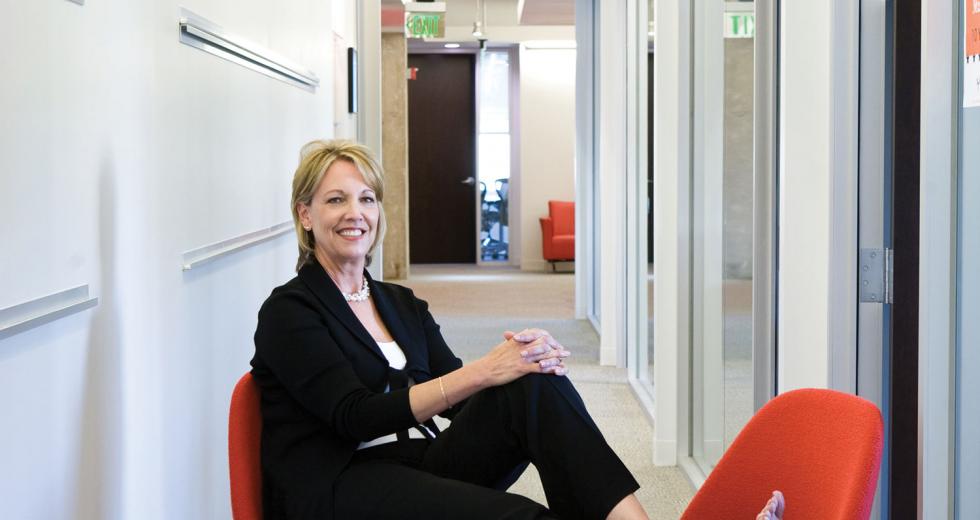The last time Christi Black went hunting for a downtown office, she found a few the right size to choose from, but none in her price range. Black, the managing director for Ogilvy Public Relations Worldwide in Sacramento, had to keep her agency in North Natomas.
This year she tried again. With commercial real estate in a slump, her phone started ringing as soon as brokers found out she was looking. The landlords’ pain was her gain.
“We had a lot of choices: all over downtown, all manner of buildings, everything from space above the Cosmo to old warehouses to former banks,” she says. She even had a shot at buildings that not so long ago were Sacramento’s premier addresses, such as the Renaissance Tower on K Street.
The spot she chose, at 1414 K St., puts her staff a block from the Capitol, next door to the Spataro restaurant and within walking distance of most meetings. She grades the space as Class A-minus, a fabulous office in a funky old building with lots of character but lacking good views.
Best of all, the rent was comparable to the old lease in Natomas.
“That was one of the requirements we had for moving there: We couldn’t make a decision that would impact the bottom line,” she says.
That old lease, by the way, still had a couple of years to run. Ogilvy had to pay to get out of it. “It was worth it,” Black says. “We wanted to take advantage of the real estate prices.” Ogilvy moved to the new office over Memorial Day weekend.
“If you are a tenant in this market, it is a 10 or a 12 on a scale of one to 10,” says John Frisch, managing partner of brokerage Cornish & Carey Commercial. “I have described this to various people as a once-in-a-generation market for tenants and buyers. That’s how good the deals are.”
Frisch has seen some buildings quoting rates at 30-year lows, which he says is “actually kind of frightening.”
The smart landlords are doing whatever it takes to keep old tenants and lure new ones. That includes free rent, bigger allowances for tenant improvements, free signs and plain old cash.
“If there is less than two years remaining on the lease, a savvy landlord really should be talking to them about extending,” Frisch says. “Oftentimes landlords and property managers don’t start that conversation until it is much later in the lease term.”
But if a tenant is in good enough financial shape to keep paying the rent, very few landlords will renegotiate a deal with more than two years left, Frisch says.
“If you’ve got three years left on your lease, it is hard to get a landlord’s attention,” he says. “And if I were a landlord, I wouldn’t worry about it. In three years we are either through this thing and rents are going up again, or it isn’t going to matter.”
That’s exactly what Ogilvy’s San Francisco office is facing, Black says. It signed up for an expensive lease just before the dot-com bubble burst. It has been able to fill up the space with its own operations and sister companies. “But, oh my God, we are paying so much money,” Black says.
“I have described this to various people as a once-in-a-generation market for tenants and buyers. That’s how good the deals are.”
John Frisch, managing partner, Cornish & Carey Commercial
If a cheaper lease will keep a good tenant from going out of business, a savvy landlord will pay attention even if there are a half-dozen years left on the contract, Frisch says. (Landlords aren’t naive. They’ll also ask the tenant to prove business is really that bad.)
But landlords aren’t going to waste time working out deals with tenants that aren’t salvageable. “The guys who are in real trouble, and we know they are in trouble, we try to make it as painless as possible to shut their business down and vacate,” says Tom O’Neil, a leasing and sales agent with MacLaughlin & Co. in West Sacramento.
MacLaughlin has had to lower rent or make concessions on about 25 percent of its properties. “For the guys we want to salvage — and this goes building by building — we have reduced their rent by as much as 25 percent, or a combination of rent and common area maintenance,” O’Neil says. “For new deals, we are giving them a pretty good rate, probably 80 percent of what we were giving them a year ago.”
Of course, not all deals are created equal.
“It all depends on the tenant, how long the lease is, how good their credit is. It’s a case-by-case deal,” says Larry Kelley, president of the 3,000-acre McClellan Park. “We’re not going out and offering concessions. If somebody’s got a real problem, and we’ve got a business plan and a proposition that makes sense, we can work with them. If not, then you don’t.”
McClellan has been improving roads and tearing down space that wasn’t functional. It should help attract new tenants and keep old ones, but all of that work was needed regardless of the economy, Kelley says.
McClellan also has unique assets that stem from its past as an Air Force base, including a gigantic runway and hangar space. If that’s what a tenant needs, there aren’t many competing options.
“I think we are ahead of where we were at this time last year,” Kelley says of occupancy rates. “I wouldn’t say it is exactly business as usual, but as much as we can, we are trying to make it that.”
Some tenants are using the weak market as a way of upgrading without spending a lot.
“We went from a B location to an A location. And we went from a building that two years ago was approaching $2.70 a foot for full service, and a marketplace that supported that, to now a fraction of that,” says Steve Bender, president and CEO of insurance brokerage Warren G. Bender Co. This past spring the brokerage moved out of the Auburn Boulevard offices it had built for itself in 1988 and leased Roseville offices that had been occupied by Shea Homes.
“If somebody’s got a real problem, and we’ve got a business plan and a proposition that makes sense, we can work with them. If not, then you don’t.”
Larry Kelley, president, McClellan Park
“Not only did we have what I think was very competitive rent, we had build-outs and amenities that were quite honestly better than what we would have done in our own building,” Bender says. “They had satellite conferencing systems, war room planning areas that we could only dream about. We were very fortunate to find what we did.”
Bender also was able to expand the office from about 9,500 square feet in multiple buildings to 11,800 square feet in a single location. The company began scouting sites in late 2007 and looked at more than 35 properties.
“We knew there was a huge inventory out there, and it was in our best interest to see every one of them,” Bender says. “We were on the speed dial for every commercial Realtor.”
Because this is a buyer’s market, some companies might want to become owners rather than renters. The trick is coming up with the money in a weak economy.
“You could find the screamin’-est deal in the world, and you are going to have a tough time getting a loan,” Frisch says. Those who have the best shot are already occupying more than half of the structure. An owner-user loan backed by the U.S. Small Business Administration is easiest to get, Frisch says. But that’s no help to buyers looking at a straight investment.
This being real estate, location is a big deal. Elk Grove took a big hit, Frisch says, as well as the small buildings in Natomas, Rocklin and Roseville. Downtown Sacramento has a cache and proximity to state offices that normally would help keep rates high. But a pair of huge office towers came on line in the past year: Bank of the West Tower and U.S. Bank Tower. Between them they added about 800,000 square feet to the downtown inventory.
“Vacancy downtown is going to go up considerably,” Frisch says. “There is no organic growth of tenants right now. All the tenants are coming from existing buildings, so they are just cannibalizing.”
Even small tenants can coax deals out of current and potential landlords. The California Urban Water Conservation Council had been paying $2.15 per square foot each month for 3,695 square feet at 455 Capitol Mall. In a report to its Finance Governance Committee, the organization says its landlord was willing to renew the lease at only $1.80 per square foot.
But the conservation organization also wanted to reduce the square footage, and its landlord refused. That sent the council on a hunt for space that would keep it near the state Department of Water Resources and the State Water Resources Control Board. Among the places it toured were:
• 1225 8th St. — 2,790 square feet at $1.75 per square foot
• 1007 7th St. — 2,800 square feet at $1.90 per square foot
• 1303 J St. — 2,800 square feet at $2.25 per square foot
• 1414 K St. — 2,800 square feet at $2.25 per square foot
• 560 J St. — 2,500 to 4,000 square feet at $1.55 per square
foot
• 2012 P St. — 2,615 square feet at $1.45 per square foot
• 2400 22nd St. — 2,582 square feet at $1 per square foot
• 555 Capitol Mall — 2,465 square feet at $2.05 per square foot
and five months of free rent.
As of early July the council was leaning toward the 8th Street property or 555 Capitol Mall, says Executive Director Chris Brown. That would drop cost per square foot by 4.6 percent to 18.6 percent and the overall cost by nearly 40 percent even without the free rent.
If that’s what a small tenant can get, consider the clout of a tenant that leases 7 million square feet of offices and about 2 million square feet of warehouses just in Sacramento County. That would be the state of California.
In April the Department of General Services sent out letters to all its landlords, saying the state would be willing to extend its current leases if the terms were good.
“We are taking a look at the entire portfolio, but some of the deals have been done recently and probably won’t be a prime candidate for this program,” says Patrick Foster, assistant chief of real estate leasing.
The standard state lease is “four and four,” which is four years with firm agreements plus four in which the state has the right to cancel. That gives the state flexibility when the market turns in mid-lease.
“We are enjoying our flexibility right now,” Foster says.
He’s not revealing the kinds of deals he’s chasing or getting because that could have an effect on future negotiations, but he’s got incentive to bargain hard. Gov. Arnold Schwarzenegger is asking departments to reduce their budgets by 15 percent, and real estate is one of the biggest costs other than personnel, Foster says.
Getting paid … but still worried
Landlords are lamenting the weak real estate market. Tenants, at least those who can negotiate a new lease, are joyful. Where does that leave the people who put landlords and tenants together to make a deal?
“It’s probably not a bad time to be a broker though there are not enough deals for anybody to get fat in this market,” says John Frisch, managing partner of Cornish & Carey Commercial. “At least in a brokerage, there are people who have to make deals even if they have to lose money on them. And there is almost always a commission to be paid on each of those deals.”
But in the long-run, even the brokers need a healthy market to stay healthy themselves.
“When you finish a deal, and the landlord says, ‘You are making more money on this deal than I am,’ that is not a good situation,” Frisch says.
Recommended For You

Farewell to the Corner Office
The next generation of workpace design
Walk into any coffee shop and it’s obvious that the place we call “the office” has changed. Many of the people sitting at tables are likely mixing laptops with lattes as they browse email and write reports. Some may be pitching a sale over coffee.

9 Ways to Sweeten Your Lease Terms
Budgets are finite—Spend smart to maximize your outcomes
Whether you’re looking for tenants or shopping for space: Here are some tips that might sweeten the deal or — if overlooked — can make one go sour.



